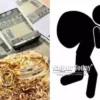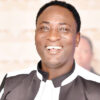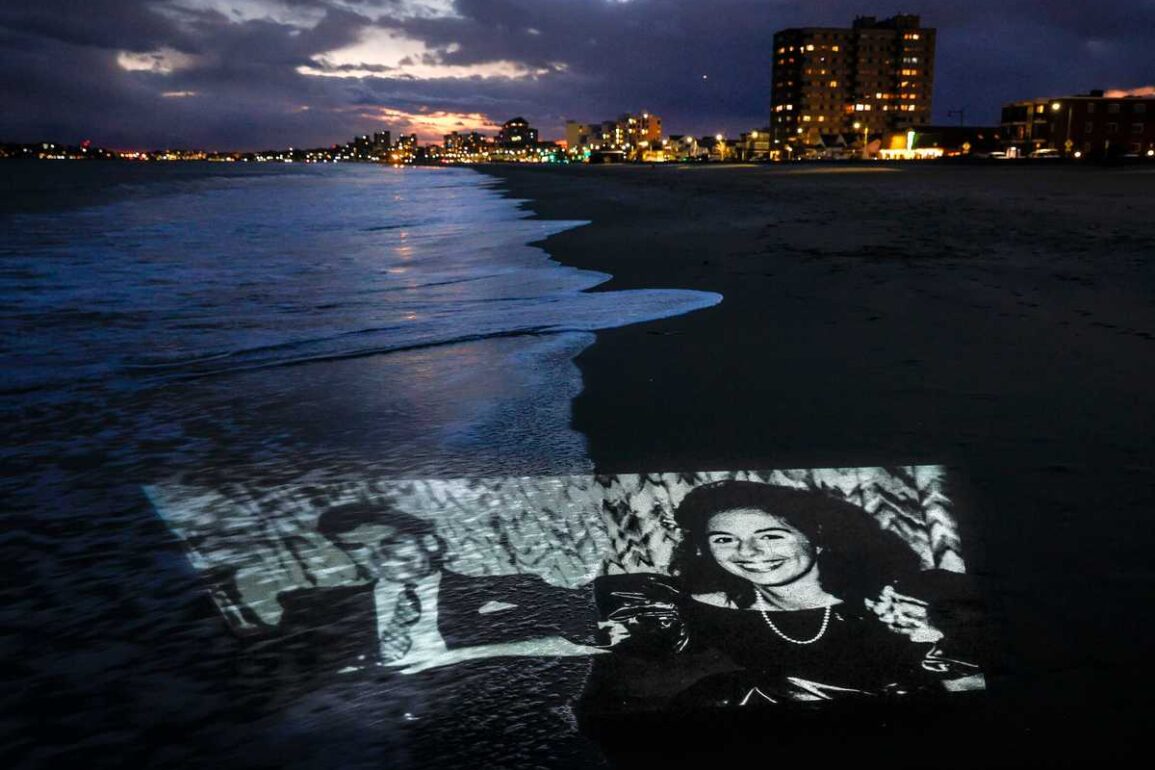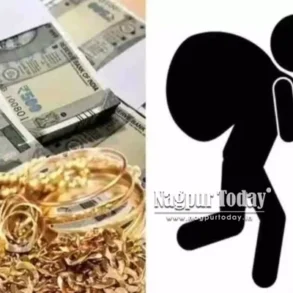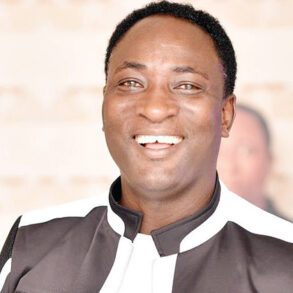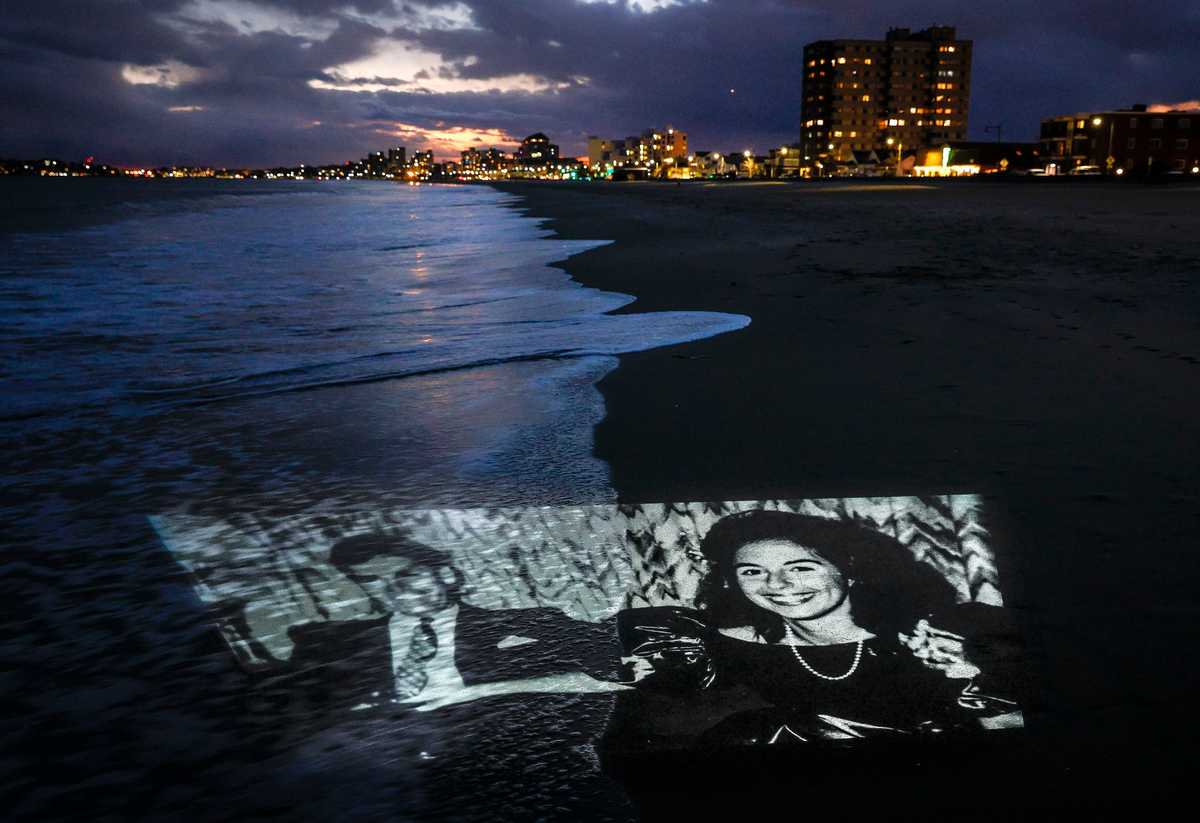
Autoplay audio
Chuck Stuart climbed into the barber’s chair and sat quietly looking at his reflection in the mirror. Hairstylist Will Zecco met his eyes in the glass.
Chuck, I just — just let me say this, Will recalls saying, stammering at the inadequacy of the words. I am so, so sorry for your loss.
Chuck gazed back, unblinking, Will remembered. The 29-year-old had just gotten out of the hospital that day, Dec. 5, 1989 — six weeks after his 911 call reporting that a gunman had jumped into his car and shot him, and his wife, Carol, as they drove home from a birthing class.
Now, his wife was dead; the couple’s first-born gone, too. The person responsible, according to police, was locked up and languishing in jail, but prosecutors had held off on charging him until Chuck was well enough to ID him in a lineup. The story felt like the only thing on TV.
I can only imagine what it would be like, if my wife and daughter — if something happened to them, the hairstylist continued.
Will had been cutting Chuck’s hair for two years at his pricey salon just off Newbury Street, a tony stretch of Boston akin, on a much smaller scale, to Fifth Avenue. Every few weeks, Chuck came in, in his dress shirt and tie and asked for a men’s regular: clean cut, over the ears, above the collar, square neckline. Chuck worked a few doors down at Edward F. Kakas & Sons, selling lavish fur coats to the jet set, and he looked like money, somewhere between Hollywood and JFK, with his square jaw and piercing eyes. Usually, Chuck was smiling, making easy, impersonal small-talk, but today he was almost mute.
Looking down tony Newbury Street from the Public Garden toward Massachusetts Avenue in Boston in 1990. (Lane Turner/Globe Staff)
Shock, Will figured. Will had been half-listening to the news all morning, so he’d known Chuck was being released, but he was surprised when the receptionist told him Chuck had made an appointment for that afternoon. Will had ushered him into a closet-sized private room at the back of the salon, where now he was lamely finishing the little speech he’d prepared for Chuck.
I don’t know what you’re going through, he concluded, but I am so, so sorry.
Will wasn’t sure what he was expecting Chuck to say. If it was him, he’d cry. But Chuck didn’t answer. His eyes shifted back to his own reflection, and silence settled like frost between them.
Will waited. And waited.
Chuck raised his hand and pointed at the side of his head. See these gray hairs over here? he said. Can you cover these up?
From the moment the first TV station aired Chuck’s desperate 911 call both Chuck and Carol had become characters in a national drama.
He was the brave husband, begging the EMTs that found him to take care of his wife first. She was the expectant mother, swelling with hope and child. Early on, the Boston Herald had christened Chuck and Carol “the Camelot Couple,” in reference to JFK and Jackie, and the moniker had stuck. Their shooting was a parable about good and evil and the rot in the heart of the American city.
But Chuck and Carol weren’t characters. They were real people.
Christine Baratta knew Carol way back, before the headlines, when Carol was a teenage waitress at a seafood joint on Revere Beach.
The Driftwood was an institution on Boston’s North Shore, frequented by a who’s who of politicians and sports heroes and jockeys from the nearby racetrack. It had 100 tables, and on weekends you had to know the maitre d’ to have any hope of getting one.
Carol had started there as a bus girl, but as soon as she turned 18 — old enough to serve liquor — she got promoted, leaving the bus girl position vacant. That’s how Christine met her: She was hired to fill Carol’s shoes.
Carol Stuart.
Which, of course, was impossible. Everybody loved Carol. She was a ball of energy, barely 5’1”, talking a mile a minute, pounding Diet Cokes, and working harder than all the boys. In photographs, Carol is all smile, and when people say she was beautiful you can see it. But that’s not really what they mean. Carol had a presence. She was funny like Lucille Ball was funny — fearless, unself-conscious, wide open. When Carol laughed she threw her head back; when she was mad, it was right there on her face. It made her easy to be with. Christine was 14 years old and in awe of this newly minted adult.
Right away, as the only two young women working at the Driftwood, they became close. Carol gave Christine rides home, then taught her to drive. She showed Christine how to apply eyeshadow and fill out college applications. They picked out Christine’s junior prom dress together, and Carol persuaded the boy Christine liked to take her to the dance.
00:00
00:00
There’s one story in particular that Christine likes to tell about Carol. For decades now, it’s been recounted in the papers as a funny urban legend about Carol’s firecracker personality. After Carol died, the staff at the Driftwood told it this way: One night, a big party stiffed her with a lousy tip, so she chased them outside and threw it back. It was the rarest sort of showdown, the shift worker versus the wealthy diner.
But it’s not exactly true. Christine saw what really happened.
Carol did get stiffed, and she did follow her party outside. But she didn’t tell them off or throw anything. She just put the tip money down on the hood of the car and walked away. When the rest of the staff went nuts over this other, crazier version, Christine asked Carol if she was going to correct them, and Carol just laughed. No, she said. I want them to think I’m a badass.
And here’s the part of the story Christine loves the most, the part that really captures the Carol she knew. At the end of the night, when Carol gave Christine her share of the night’s tips, it was more money than Carol went home with herself. Never said a thing about it.
It was at the Driftwood that Carol met Chuck.
Chuck grew up in Revere, not far from the restaurant, in a three-bedroom house at the end of a cul-de-sac. He was the eldest son of six kids in a working-class Irish Catholic family, and his youngest brother, Matthew, worked at the Driftwood too, washing dishes. Their dad sold insurance, their mom was a homemaker, and they went to Mass every Sunday at the Church of the Immaculate Conception where Chuck served as an altar boy.
Charles Stuart and Carol DiMaiti, shown in 1987, began dating after meeting at the Driftwood.
But Chuck always dreamed of a better, more refined life. He told a story about himself that sounded good but wasn’t true: That he took the job as a cook at the Driftwood after blowing his knee out playing football at Brown University on a sports scholarship. He still looked like an athlete, though, tall and chiseled. He and Carol would catch each other’s eyes across the line.
Carol’s dad, Giusto, tended bar at the Driftwood, and, by all accounts, he didn’t like Chuck much. Giusto was protective of Carol and so proud of her that he carried one of her straight-A report cards in his wallet. Theirs was an old-school Italian family that held big dinners on Sundays, and Carol was the baby. Chuck could be charming, but he was reserved — still water that might run deep.
Carol fell for him hard, and that was it. On Christmas Eve in 1983, Chuck gave her a wallet embossed with her initials — but instead of the “D” for “DiMaiti,” it had an “S” for “Stuart.” Inside was a diamond ring. They married in ‘85.
Carol graduated from Boston College with a degree in political science and went to Suffolk Law; Chuck got his job at Kakas Furs on Newbury Street. In 1987, they bought a little house with a hot tub and a pool on Harvest Road in the affluent town of Reading, where many of their neighbors commuted to white-collar jobs in Boston.
Chuck and Carol were each moving further from their working-class roots.
Kakas Furs, where Chuck hoped to become the manager, was a grand stone building; to enter, you had to be buzzed in. A scrappy guy from Revere could certainly look in the windows, but to get any further, he was going to need some polish. And Chuck had it. He wore sharp suits and leather shoes, and he spent his days gliding across the Oriental rugs in the showroom, sweet talking the upper crust.
An employee at Kakas Furs adjusted the coats on the racks on Jan. 3, 1990. Chuck Stuart was general manager at the posh Newbury Street store, which sold lavish fur coats to the jet set. (Paul Benoit/Globe Staff)
Carol got a job at an accounting firm and then a publishing house, and she put in long hours. But unlike Chuck, she never seemed like she was trying to leave her old life behind. She still brought her own lunch to work and ate in the lunchroom with the secretaries. On late nights, her dad would show up with pizzas for her and her colleagues. When they all went out after work, it was Carol at the bar belting out “Ain’t no mountain high enough” off-key at the top of her lungs and laughing until she cried.
00:00
00:00
To the outside world, Chuck and Carol appeared to have an ideal marriage. He took her to New York, to plays, to fancy restaurants, and he bought her beautiful jewelry. Of course, they fought — like any couple. Sometimes Carol, who felt everything deeply, would show up to work with red-rimmed eyes. But what her coworkers remember were not the details of the skirmishes, but the gorgeous long-stemmed roses that showed up in apology afterwards.
They seemed to have a fairytale life, and when Carol got pregnant in 1989, the final piece fell into place. Having a family had always been her dream.
After the murder, Carol’s pregnancy became the shocking centerpiece of the crime. But before it was a sensational headline, it was a private joy for Carol. She was a romantic, and the feeling of a new life growing in her belly was an almost sacred experience.
She and Chuck decorated the nursery and signed up for a childbirth class at Brigham and Women’s Hospital.
They spent the evening of Oct. 23, 1989 — their last hour as Chuck and Carol — at that class at the Brigham, learning about what happens in the event of a caesarean section. Carol asked lots of questions and took scrupulous notes. Chuck sat beside her, pale and quiet, with what the other students assumed was a terrible case of nerves.
A photograph of Evelyn DiMaiti at her daughter Carol’s funeral in 1989 is projected outside of Brigham and Women’s Hospital. Carol, who had just left a birthing class at the hospital, was taken back to the Brigham after being shot in nearby Mission Hill. (Erin Clark/Globe Staff)
They left the Brigham around 8:30 p.m., and a few minutes later, Chuck called 911. “My wife’s been shot,” he said. “I’ve been shot.”
Then came the ambulance gurneys, the clicks of photojournalists’ cameras, the crime scene tape.
After that, they were the Camelot Couple.
Once the Boston police arrested Willie Bennett in November of 1989, things quieted a bit. The police assault on Mission Hill eased. Some questions lingered, but the institutions did what they always do: City Hall demanded a swift result; the police booked a suspect; the media chronicled every dip and turn in the police-provided narrative.
December in Boston that year was the coldest in more than a century. The Bruins were crushing it, on their way to the Stanley Cup Finals. And the Celtics were riding high, though Larry Bird’s superpowers were starting to fade.
The Stuart story still dominated the newscasts and the papers, but it had been two months since Carol and Christopher died, and they didn’t always make page one anymore. Willie was jailed on charges that had nothing to do with the shooting. He was still the main suspect in the Stuart case, but no murder charges had been filed — yet.
Around Christmas, Chuck booked another appointment with Will Zecco at the salon off Newbury Street.
His gray was starting to show again, and now, he had an appointment at police headquarters to get ready for. He knew the media would be there, with their cameras, and he wanted to look good.
This time, Will didn’t try to talk to Chuck — he found Chuck’s whole demeanor unnerving. He put Chuck back in the private room, put the dye on his head, and stepped out to wait for it to set. As he closed the door behind him, Will could see Chuck’s face reflected in the mirror. He was staring impassively into his own eyes.
00:00
00:00
Will didn’t know what to think of his longtime client. He had always liked Chuck. They had a rapport — or at least, Will thought they did. Now, he wasn’t so sure. During all those haircuts, all those conversations when Will had talked about his own wife and his child — Chuck had never once mentioned that he had a baby on the way. He didn’t wear a wedding ring. In fact, Will didn’t even realize Chuck was married, until he saw it on the news.
Chuck arrived at police headquarters on Dec. 28, 1989, with his hair freshly colored and his jacket collar popped. He was there with his attorney to view the lineup, where he picked Willie Bennett — suspect number 3 — out of the row of eight Black men holding numbered placards.
In an interview room after he made the identification, he told police he recognized Willie’s jawline and the shape of his ear. Chuck told detectives he was 99 percent sure that number 3 was the shooter. His right-side profile was a perfect match.
But prosecutors still didn’t charge Willie with murder. There were rumors in news reports about Chuck’s identification being shaky. But the sources were anonymous and officials refused to comment.
In the waning days of December, Boston set aside the Stuart case to celebrate the New Year.
Rain-soaked attendees admired an ice sculpture at Copley Square during First Night festivities in Boston on Dec. 31, 1989. (Bill Greene/Globe Staff)
“1989, going out with a song, a shimmy, and a splash!” declared one newscaster, before the camera panned to a 40-foot neon piano surrounded by dancing revelers on Boston Common. It had been a roller coaster of a year: the fall of the Berlin Wall, the Exxon Valdez oil spill, that terrible night in Mission Hill.
Dick Clark counted down, and the ball dropped, and the people screamed. It was 1990, a brand new decade, a fresh start.
But up on the North Shore, the past was about to catch up with the Stuarts.
On the evening of Jan. 3, 1990, the emergency phone at a Revere fire station where Chuck Stuart’s younger brother, Michael, worked as a firefighter recorded a volley of phone calls between the Stuart siblings.
“Michael, we’re all meeting here, right now,” his sister Shelley says in one. Michael says he can’t get out of work, but Shelley tells him to talk to his boss. “It can’t be an emergency crisis at home?“
The recording is scratchy, but you can hear the heaviness in their voices. They both sound like they’ve been awake all night.
“I suppose I could say that, but –”
She cuts him off. “Say it, Mike. Because it is.”
“What’s gonna happen?” he asks her.
“We’re gonna tell Mom and Dad,” she says.
Advertisement
This post was originally published on this site be sure to check out more of their content.

